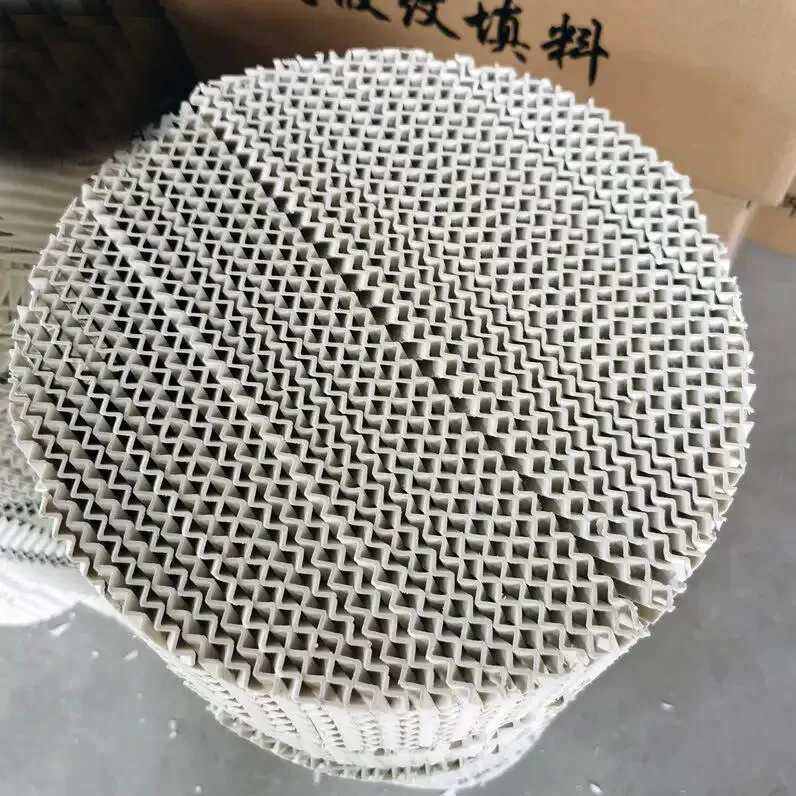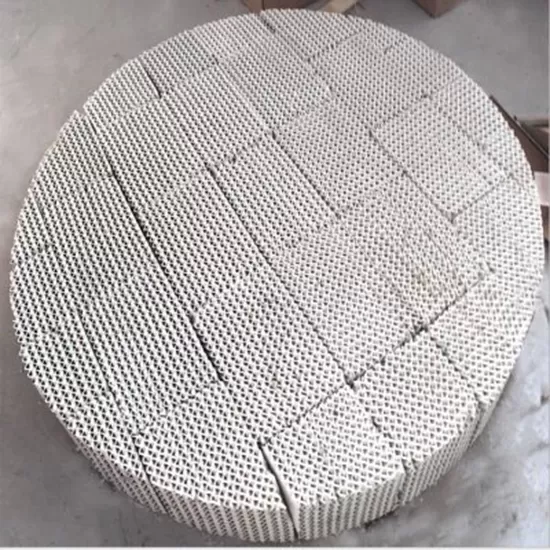The ceramic corrugated structured packing has a high specific surface area, which offers significant advantages in terms of increasing output, reducing energy consumption, and enhancing power. Moreover, since the packing can be placed in an orderly manner, the solid particles contained in the material can be discharged through the bottom of the corrugations of the packing, thus demonstrating excellent anti-blocking performance.

The main material for preparing ceramic corrugated packing is silicon dioxide-alumina ceramic material which is acid-resistant and chemically corrosion-resistant. This ceramic material is very sturdy, with a temperature resistance of up to 1300℃, and a service temperature as low as -1000℃. It can resist all inorganic acids, organic acids, acidic gases and neutral gases except hydrofluoric acid, which helps to extend the service life of the packing.
Chemical component
| SiO2 | Fe2O3 | CaO | Al2O3 | MgO | Other |
| ≥72% | ≤0.5% | ≤1.0% | ≥23% | ≤1.0% | 2% |
Characteristics
| model | specific surface area(m2/m3) | bulk density (kg/ m3) | voidage(%) | angle of inclination | pressure drop | number of theoretical plates (m-1) | hydraulic diameter (mm) | Liquid load (m3/m2h) | Factor F (Kg/m3)-1 |
| (mmHg/m) | |||||||||
| 125Y | 125 | 320 | 90 | 45° | 1.8 | 1.8 | 28 | 0.2-100 | 3 |
| 160Y | 160 | 370 | 85 | 45° | 2 | 2 | 15 | 0.2-100 | 2.8 |
| 250Y | 250 | 420 | 80 | 45° | 2 | 2.5 | 12 | 0.2-100 | 2.6 |
| 350Y | 350 | 470 | 78 | 45° | 2.5 | 2.8 | 10 | 0.2-100 | 2.5 |
| 400Y | 400 | 500 | 75 | 45° | 3 | 3 | 8 | 0.2-100 | 2 |
| 450Y | 450 | 520 | 72 | 45° | 4 | 4 | 7 | 0.2-100 | 1.8 |
| 550Y | 550 | 620 | 74 | 45° | 5.5 | 5-6 | 6 | 0.18-100 | 1.4 |
| 700Y | 700 | 650 | 72 | 45° | 6 | 7 | 5 | 0.15-100 | 1.3 |
| 100X | 100 | 280 | 92 | 30° | 1.5 | 1 | 30 | 0.2-100 | 3.5 |
| 125X | 125 | 300 | 90 | 30° | 1.8 | 1.5 | 28 | 0.2-100 | 3.2 |
| 160X | 160 | 350 | 85 | 30° | 2 | 1.8 | 15 | 0.2-100 | 3 |
| 250X | 250 | 380 | 80 | 30° | 2.5 | 2.3 | 12 | 0.2-100 | 2.8 |
| 350X | 350 | 450 | 78 | 30° | 3 | 2.5 | 10 | 0.2-100 | 2.6 |
| 400X | 400 | 480 | 75 | 30° | 4 | 2.8 | 8 | 0.2-100 | 2.2 |
| 450X | 450 | 500 | 72 | 30° | 4.5 | 3-4 | 7 | 0.2-100 | 2 |
| 470X | 470 | 440 | 75 | 30° | 5 | 5 | 7 | 0.2-100 | 1.8 |
| 550X | 550 | 620 | 74 | 30° | 5.5 | 5-6 | 6 | 0.18-100 | 1.4 |
| 700X | 700 | 650 | 72 | 30° | 6 | 7 | 5 | 0.15-100 | 1.3 |

The bulk density of ceramic regular packing materials is influenced by multiple factors, mainly including the following aspects:
1. Fill material shape: Different shapes of fillers will result in different gap sizes when piled up, and thus the packing density will also vary. Generally speaking, the packing density of spherical fillers is relatively higher.
2. Particle size: The size of the filler particles has a significant impact on the bulk density. Generally speaking, the larger the particles, the larger the gaps formed during the packing process, resulting in a lower bulk density.
3. Fill material: The density and porosity of the fill material are also significant factors influencing the bulk density. Materials with higher density have greater mass in the same volume, while materials with higher porosity may have a lower bulk density due to the presence of more internal voids.


.png)
.jpg)
.jpg)
.jpg)
.jpg)
.jpg)
.jpg)